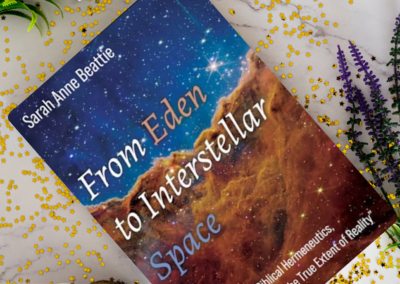by Nicola Hoggard Creegan
In our upcoming conference Beyond Conflict: Evolution, Science and God, we will among other things, be exploring different understandings of evolution, both at the level of mechanism and philosophically. This blog, then, is a short excursus on thinking about evolution in what the great anthropologist Tim Ingold would call the “minor key.”
The natural world presents itself as stunning in its beauty, interdependency and vibrancy and in the agency of even the most simple creature. But evolutionary explanations for all this sometimes have a flattening and deadening effect when mutation and selection are understood as the only cause of all the interconnected dynamic yearning and striving. It is intriguing, then, to read several sets of unrelated but interesting articles or reviews written about evolution in the last few months. These are breaking out of traditional intellectual paradigms, or seeing fresh meaning in our long evolutionary becoming.
First, there have been two reviews and a magazine piece in the New York Times, of a book on beauty and evolution.[1] Richard Prum argues in The Evolution of Beauty, that beauty is an independent driver of evolution, along with natural selection and other mechanisms. Beauty cannot always be reduced to adaptive advantage, he argues. In fact, his position would be that beauty is almost always not adaptive, that arbitrary beauty is ubiquitous. He argues that the agency of ‘irrational’ creatures, mostly female, and their aesthetic choice is of great importance in evolutionary progression. Interestingly, Darwin also played with this idea. Prum’s is a fascinating theory, and very controversial, among mainstream biologists, many of whom wish to subsume beauty under fitness even when we can’t understand how. But Prum is adamant that beauty is independent; it escapes, in a sense, the reductive calculus. This is interesting for several reasons. The first is that biologists disagree about the deepest causes of what is going on. That gives philosophy and theology some wriggle room when it comes to entering the discussion.
And secondly, beauty is also a religious and spiritual category. The psalms, for instance, speak powerfully of God’s beauty, and the beauty of the reflected natural world. If once you have escaped the reductionism of inevitable causation alone, and you admit animal agency into the mystery of life, then it is not such a huge leap to add another level – the divine – to the synthesis as well. For many understandings of divinity link beauty with transcendence; In theology and in philosophy there is an apparent synergy between delight in perception, and aesthetics as a part of the wider imprint of divinity on all matter. Houses of worship, especially the great medieval cathedrals, reflect a belief that beauty and symmetry are not far from godliness. Not that Prum goes here. He is indifferent to the causes of aesthetic appreciation, just sure that it has been an important driver of beautiful animals.
One theologian who saw beauty as a harbinger of God was the 18thcentury American theologian Jonathan Edwards. He wrote at length in The Nature of True Virtue, that symmetry and loveliness were lower forms of love.[2] The highest form of love was the “Consent to Being” in the Godhead. In any complex system there will be causality and explanation at many different levels. The Christian does not deny the causal explanations of survival and adaptation – or if informed a Christian need not deny these – but will reflect also on the striving, the energy, the beauty of life and its origins in ultimate love and beauty. For a Christian life must not be ultimately reducible to the impersonal.
But the other series of reflections on evolution comes from a different and very religious source, the mystic Franciscan, Richard Rohr. He has started a year-long meditation on evolution and spirituality. He notes, for instance, that evolution is familiar with the rubric of death and new life. Change and creativity depend upon it. He thinks that means we should embrace the darker sides of life (this call can only be taken so far of course) because out of even our deepest disappointments comes new life if we can see it or allow it.
But Rohr also calls us to embrace the messiness of embodied finite life, a life taken up by the Son of God. He says:
Evolutionary thinking is actually contemplative thinking because it leaves the full field of the future in God’s hands and agrees to humbly hold the present with what it only tentatively know for sure. Evolutionary thinking must agree to both knowing and not knowing, at the same time.
The New Testament shows history working in a way that is both evolutionary and positive . . . growth and development.
All of this is interesting. It shows that some of the deeper conversations in evolutionary biology touch on questions of value and metaphysics that are in the religious domain as well. Proof that the interface between science and theology runs much deeper than a split between asking ‘how’ and asking ‘why’. Rohr’s writing shows that truly understood evolutionary biology is connected to deep moral lessons of faith. They aren’t at odds with each other as we might once have thought. And evolution encourages us as conscious agents and products of evolution to take an active part in the divine history of the cosmos. We can’t do this by understanding where we are going in detail, or by having a God’s eye view of telos. But we can as human agents, discern both goodness and beauty and these can be our guides.
[1]Richard O. Prum, The Evolution of Beauty: How Darwin’s Forgotten Theory of Mate Choice Shapes the Animal World –and Us, Doubleday, 2017. Reviewed by James Gorman, ‘Challenging Mainstream Thoughts about Beauty’s Big Hand in Evolution,’ New York Times,May 29, 2017; & David Dobbs, “Survival of the Prettiest,” New York Times,Sept 18, 2017; & Ferris Jabr, “How Beauty is Making Scientists Rethink Evolution,” New York Times, Jan 9, 2019.
[2]Jonathan Edwards, “The Nature of True Virtue.” Ethical Writings,Vol. 8 of The Works of Jonathan Edwards, ed. Paul Ramsey, Yale University Press, 1989.



